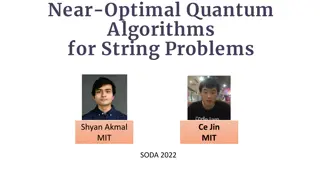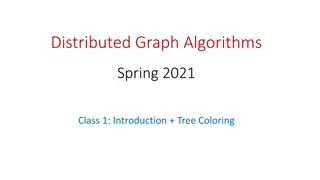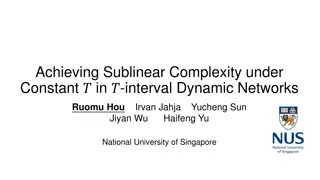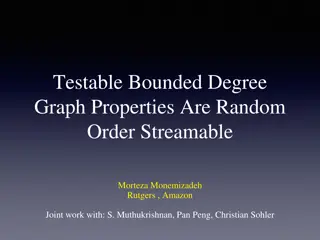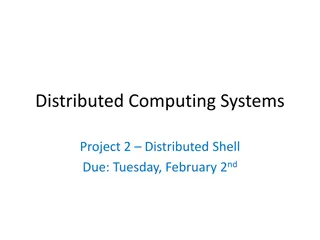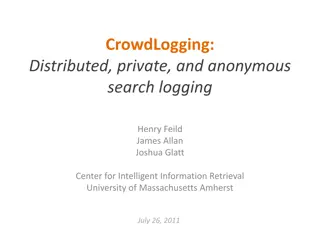Understanding Sublinear Algorithms and Graph Parameters in Centralized and Distributed Computing
Centralized sublinear algorithms and their relation to distributed computing are explored, emphasizing the efficiency of algorithms in processing large inputs in sublinear time. Examples of sublinear algorithms for various objects are provided, along with the computation and approximation of graph parameters efficiently in centralized settings. The need for sublinear-time algorithms in handling very large inputs is discussed in the context of achieving approximate solutions with high success probability.
Download Presentation

Please find below an Image/Link to download the presentation.
The content on the website is provided AS IS for your information and personal use only. It may not be sold, licensed, or shared on other websites without obtaining consent from the author. Download presentation by click this link. If you encounter any issues during the download, it is possible that the publisher has removed the file from their server.
E N D
Presentation Transcript
On Centralized Sublinear Algorithms and Some Relations to Distributed Computing Dana Ron Tel-Aviv University ADGA, October 2015
Efficient (Centralized) Algorithms Usually, when we say that an algorithm is efficient we mean that it runs in time polynomial in the input size n (e.g., size of an input string s1s2 sn, or number of vertices in a graph ). Naturally, we seek as small an exponent as possible, so that O(n2) is good, O(n3/2log3(n)) is better, and linear time O(n) is really great! But what if n is HUGE so that even linear time is prohibitive? Are there tasks we can perform super- efficiently in sub-linear time? Supposedly, we need linear time just to read the input without processing it at all. But what if we don t read the whole input but rather sample from it? s1s2 si sj sn
Sublinear Algorithms Given query access to an object O, perform computation that is (approximately) correct with high (constant) probability, after performing as few queries as possible. Sublinearity is in a sense inherent in distributed computing ? ? ? ? ? To define task precisely, must specify: object, query access, desired computation and notion of approximation
Examples The object can be an array of numbers and would like to decide whether it is sorted The object can be a function and would like to decide whether it is linear (corresponds to the Hadamard Code) The object can be an image and would like to decide whether it is a cat/is convex. The object can be a set of points and would like to approximate the cost of clustering into k clusters (according to some objective function) The object can be a graph and would like to approximate some graph parameter.
Graph Parameters A Graph Parameter: a function that is defined on a graph G (undirected / directed, unweighted / weighted). For example: Average degree Number of subgraphs H in G Number of connected components Minimum size of a vertex cover Maximum size of a matching Number of edges that should be added to make graph k-connected (distance to k-connectivity) Minimum weight of a spanning tree
Computing/Approximating Graph Parameters Efficiently For all parameters described in the previous slide, have efficient, i.e., polynomial-time algorithms for computing the parameter (possibly approximately). For some even linear-time. However, in some cases, when inputs are very large, we might want even more efficient algorithms: sublinear-time algorithms. Such algorithms do not even read the entire input, are randomized, and provide an approximate answer (with high success probability).
Sublinear Approximation on Graphs Algorithm is given query access to G. Types of queries that consider: Neighbor queries who is ithneighbor of v? Degree queries what is deg(v)? Vertex-pair queries is there an edge btwn u and v? After performing number of queries that is sublinear in size of G, should output good approximation of (G), with high constant probability (w.h.c.p.). Types of approximation that consider: (G) (1+ ) (G) (for given : a (1+ )-approx.) (G) (G) (for fixed : an -approx.) (G) (G) + n (for fixed and given where n is size of range of (G) : an ( , )-approx.) ? + weight of edge
Survey Results in 3 Parts I. Average degree and number of subgraphs II. Size of minimum vertex cover and maximum matching III. Minimum weight of spanning tree
Part I: Average Degree Let davg= davg(G) denote average degree in G, davg 1 (can compute exactly in linear time) Observe: approximating average of general function with range {0,..,n-1} (degrees range) requires (n) queries, so must exploit non-generality of degrees Can obtain (2+ )-approximation of davgby performing O(n1/2/ ) degree queries [Feige]. Going below 2: (n) queries [Feige]. With degree and neighbor queries, can obtain (1+ )- approximation by performing (n1/2poly(1/ )) queries [Goldreich,R]. Comment1: In both cases, can replace n1/2with (n/davg)1/2 Comment2: In both cases, results are tight (in terms of dependence on n/davg).
Average Degree (cont) Ingredient 1: Consider partition of all graph vertices into r=O((log n)/ ) buckets: In bucket Bivertices v s.t. (1+ )i-1 < deg(v) (1+ )i Suppose can obtain for each i estimate bi=|Bi| (1 (1/n) i bi (1+ )i= (1 How to obtain bi? By sampling (and applying [Chernoff]). Difficulty: if Biis small (<< n1/2) then necessary sample is too large ((|Bi|/n)-1>> n1/2). ( = /8 ) ) ) ) davg (*) Ingredient 2: Ignore small Bi s. Take sum in (*) only over large buckets (|Bi| > ( n)1/2/2r). (1/n) large i bi (1+ )i davg/(2+ ) Claim: (**)
Average Degree (cont) Claim: (1/n) large i bi (1+ )i davg/(2+ ) (**) Sum of degrees = 2 num of edges (small: |Bi| ( n)1/2/2r, r : num of buckets) small buckets large buckets counted twice not counted counted once Using (**) get (2+ )-approximation with (n1/2/ 2) degree queries Ingredient 3: Estimate num of edges counted once and compensate for them.
Average Degree (cont) Ingredient 3: Estimate num of edges counted once and compensate for them. large buckets small buckets Bi For each large Biestimate num of edges between Biand small buckets by sampling neighbors of (random) vertices in Bi. By adding this estimate eito (**) get (1+ )-approx. (1/n) large i bi (1+ )i (1/n) large i (bi (1+ )i + ei) (**)
Part I(b): Number of subgraphs - Stars Approximating avg. degree same as approximating num of edges. What about other subgraphs? (Also known as counting network motifs.) [Gonen,R,Shavitt] considered length-2 paths, and more generally, k-stars. (avg deg + 2-stars gives variance, larger k higher moments) Let sk= sk(G) denote num of k-stars. Give (1+ )-approx algorithm with query complexity (degree+neighbors): / 1 k k n k n / 1 + 1 k min , (log / 1 , n ) O n poly ) 1 + / 1 1 k /( 1 k k s s Show that this upper bound is tight.
Part I(c): Number of subgraphs - Triangles Counting number of triangles t=t(G) exactly/approximately studied quite extensively in the past. All previous algorithms read entire graph. [Gonen,R,Shavitt] showed that using only degree and neighbor queries there is no sublinear algorithm for approximately counting num of triangles. Natural question: What if also allow vertex-pair queries? [Eden,Levi,R,Seshadhri] Give (1+ )-approx algorithm with query complexity (degree+neighbors+vertex-pairs): O(n/t1/3+ m3/2/t) poly(log n,1/ ) and give matching lower bound.
Part II: The Minimum Vertex Cover (VC) Recall: For a graph G = (V,E), a vertex cover of G is a subset C V s.t. for every {u,v} E, {u,v} C Computing the size of a minimum vertex cover is NP-hard, but a factor-2 approx can be found in linear time [Gavril], [Yanakakis] Can we get approx even more efficiently, i.e., in sublinear-time?
Min VC (Imaginary) Oracle Initially considered in [Parnas,R]. First basic idea: Suppose had oracle that for given vertex v answers if v C for some fixed vertex cover C that is at most factor larger than min size of vertex cover, vc(G). v? https://encrypted-tbn1.gstatic.com/images?q=tbn:ANd9GcRg3OlsBXkJV7KxcM7lkx_KA6s98HW2aRfDi7bC2f4iQHQIjwNt Consider uniformly and independently sampling s= (1/ 2) vertices, and querying oracle on each sampled vertex. v C ! v C ! Let svcbe number of sampled vertices that answers: in C. By Chernoff, w.h.c.p |C|/n- /2 svc/s |C|/n+ /2 Since vc(G) |C| vc(G), if define vc = (svc/s + /2)n then (w.h.c.p) vc(G) vc vc(G) + n That is, get ( , )-approximation
Min VC: Distributed connection Second idea: Can use distributed algorithm to implement oracle. Suppose have dist. alg. (in message passing model) that works in k rounds of communication. Then oracle, when called on vertex v, will emulate dist. alg. on k-distance-neighborhood of v https://encrypted-tbn1.gstatic.com/images?q=tbn:ANd9GcRg3OlsBXkJV7KxcM7lkx_KA6s98HW2aRfDi7bC2f4iQHQIjwNt v v C ! v? Query complexity of each oracle call: O(dk) where d is max degree in the graph.
Min VC - Results By applying dist. alg. of [Kuhn,Moscibroda,Wattenhofer] get (c, )-approx. (c>2) with complexity dO(log d)/ 2, and (2, )-approx. with complexity dO(d)poly(1/ ). Comment 1: Can replace max deg d with davg/ [PR] Comment 2: Going below 2 : (n1/2) queries (Trevisan) 7/6: (n) [Bogdanov,Obata,Trevisan] Comment 3: Any (c, )-approximation: (davg) queries [PR] Sequence of improvements for (2, )-approx [Marko,R]: dO(log(d/ )) - using dist. alg. similar to max ind. set alg of [Luby] [Nguyen,Onak]: 2O(d)/ 2 emulate classic greedy algorithm (maximal matching) [Gavril],[Yanakakis] [Yoshida,Yamamoto,Ito]: O(d4/ 2) sophisticated analysis of better emulation [Onak,R,Rosen,Rubinfeld]: (davgpoly(1/ ))
Min VC: [NO] Algorithm Factor-2 approx alg of [Gavril],[Yanakakis] (not sublin) C , U E (C: vertex cover, U: uncovered edges, ) while U - select (arbitrarily) e = {u,v} in U - C C {u,v} (add both endpoints of e to cover) - U U \ ({ {u,w} E } { {v,w} E } ) (remove from U all edges covered by u or v) Slightly different description of alg: C , U E, For j = 1 to |E| - If j= {u,v} in U: C C {u,v} U U \ ({ {u,w} E } { {v,w} E } ) arbitrary permutation of E ,M 5 2 7 3 8 4 1 6 , M M { {u,v} }
Min VC: [NO] Algorithm (cont) Let M (G) be maximal matching resulting from alg when using permutation (so that vc(G)/2 |M (G)| vc(G) ) Can estimate vc(G) by estimating |M (G)|: sample (1/ 2) edges uniformly; for each check if in M (G) by calling maximal matching oracle. Basic observation: For an edge e = {u,v}, if for some e = {u,w} (or {v,w}), (e ) < (e) and e in M (G) then e not in M (G). Otherwise, e in M (G) . MO (input: edge e = {u,v}, output: is e in M (G)) For each edge e e incident to u or v - if (e ) < (e) if MO (e ) = TRUE then return FALSE return TRUE 5 8 e e
Min VC: [NO] Algorithm (cont) MO (input: edge e = {u,v}, output: is e in M (G)) For each edge e e incident to u or v - if (e ) < (e) if MO (e ) = TRUE then return FALSE return TRUE Main claim of [NO]: For a randomly selected , the expected query complexity of oracle is 2O(d). Analysis based on bounding (in expectation) the total number of edges reached in recursive calls (sequence of recursive calls corresponds to sequence of decreasing values). Note: can select on the fly , by assigning each new edge considered a random (discretizied) value in [0,1].
From exp(d) to poly(d) and approximate Maximum Matching [YYI] analyzed a variant suggested by [NO] and proved that expected number of oracle calls for variant is O(d2), resulting in poly(d,1/ ) complexity (and [ORRR] further modified alg to get almost optimal complexity). Same algs give (roughly) -approx for maximum matching. [NO] and [YYI] build on alg and [Hopcroft&Karp] to get (1- )-approx using exp(dO(1/ )) (dO(1/ ), resp.) queries
Distributed Connection Revisited Previously observed that can implement VC-oracle based on known distributed algorithm(s) Now observe that oracle implementation of [NO] for approx-max-match gives distributed algorithm that performs dO(1/ )rounds and has high constant success probability. Compare to O(log(n)/ 3)-round alg of [Lotker, Patt- Shamir,Pettie] that has success prob 1-1/poly(n) A different distributed algorithm, using ideas from [NO] as well as distributed coloring alg [Linial], performs dO(1/ )+ log*(n)/ 2 rounds, and succeeds with prob 1 [Even,Medina,R] (Studied in context of Centralized Local Algorithms)
Part III: Min Weight Spanning Tree Consider graphs with degree bound d and weights in {1,..,W}. Goal is to approx weight of MST [Chazelle,Rubinfeld,Trevisan] give (1+ )-approximation alg using (d W/ 2) neighbor queries. Result is tight and extends to d=davgand weights in [1,W]. Suppose first: W=2 (i.e., weights either 1 or 2) E1= edges with weight 1, G1=(V,E1), c1= num of connected components in G1. Weight of MST: 2 (c1-1) + 1 (n-1-(c1-1)) = n-2+c1 Estimate MST weight by estimating c1
MST (cont) More generally (weights in {1,..,W}) Ei= edges with weight i, Gi=(V,Ei), ci= num of connected components (cc s) in Gi. Weight of MST: n - W + i=1..W-1ci Estimate MST weight by estimating c1, ,cW-1. Idea for estimating num of cc s in graph H (c(H)): For vertex v, nv= num of vertices in cc of v. Then: c(H) = v(1/nv) 3 (1/3) 4 (1/4) 2 (1/2)
MST (cont) c(H) = v(1/nv) (nv= num of vertices in cc of v) Can estimate c(H) by: selecting sample R of vertices, for each v in R, finding nv(using BFS) and taking (normalized) sum over sample: (n/|R|) v R(1/nv) Difficulty: if nvis large, then expensive Let S = {v : nv B}. (S for small ) v S(1/nv) > c(H) n/B Alg for estimating c(H) selects sample R of vertices, runs BFS on each selected v in R until finds nvor determines that nv> B (i.e. v S). Estimate c(H) by (n/|R|) v R S(1/nv) Complexity: O(|R| B d) v
MST (cont) For any < 1, if set B=2/ and |R| = (1/ 2) get estimate of C(H) to within n with complexity O(d/ 3) Alg for estimating MST weight can run above alg on each Gi with = /W, so that when sum estimates of ci for i=1, ,W get desired (1 ) approximation. (Gi=(V,Ei), Ei= edges with weight i) (ci= num of connected components in Gi) (Weight of MST: n - W + i=1..W-1ci) Comment: [Chazelle,Rubinfeld,Trevisan] get better complexity (total of (d W/ 2) ) by more refined alg
Summary Talked about sublinear approximation algorithms for various graph parameters: I. Average degree and number of stars and triangles II. Size of minimum vertex cover (maximum matching) III. Weight of minimum weight spanning tree There is a high-level connection to distributed computing through sublinearity, and there some are concrete algorithmic connections
From [NO] to [YYI] [NO] suggested following greedy variant: MO (input: edge e = {u,v}, output: is e in M (G)) Query G on all edges incident to u and v. Let e1, ,et be ordering of edges according to (i.e., (ej)< (ej+1) ) j 1 while (ej)< (e) - if MO (ej) = TRUE then return FALSE - else j j+1 return TRUE 3 4 10 7 e 2 1 6 [YYI] analyzed variant and proved that expected number of queries for variant is O(d2), resulting in algorithm with query complexity O(d4/ 2) (extra factors of d due to prob of selecting e in M (G) being |M (G)| / (d n) )
Part III(b): Maximum Matching and more [Nguyen,Onak] give (1, )-approx for max match with complexity 2d*O(1/ ), improved [Yoshida,Yamamoto,Ito] to d6/ *2(1/ )O(1/ ) Recursive application of oracles using augmenting paths. [Hassidim,Kelner,Nguyen,Onak],[Elek] give (1, )-approx algs on restricted graphs (e.g., planar) Can get (O(log d), )-approx for min dominating set with complexity dO(log d)/ 2using [Kuhn,Moscibroda,Wattenhofer]
Part I(b): Number of stars subgraphs n n N s Ns n1+1/s: O(n/(Ns)1/(1+s)) n1+1/s Ns ns: O(n1-1/s) Ns> ns: O(ns-1/s/(Ns)1-1/s) = O((ns+1/Ns)1-1/s) Example: s=3. (a) Ns= n : O(n3/4); (b) Ns= n2: O(n2/3); (c) Ns= n4: O(1) Idea of algorithm for s=2: Also partition into buckets. Can estimate num of 2-stars with centers in large buckets. Also estimate num of 2-stars with centers in ( significant ) small buckets and at least one endpoint in large bucket by estimating num of edges between pairs of buckets. 1 / s s n + 1 1 / s min , (log 1 , n / ) O poly + 1 /( 1 ) 1 s 1 / s s N + i 1 ( ) ib 2
Part IV: Approximating Distance to P For graph property P, estimate fraction of edges that should be added/removed to obtain P (fraction with respect to (ub on) num of edges m). Assume m= (n). Study of distance approximation first explicitly introduced in [Parnas,R,Rubinfeld]. Note: Already discussed alg for distance to connectivity in sparse graphs (estimate num of cc s) For dense graphs where m= (n2) and perform vertex- pair queries, some known testing results directly give dist. approx. results: e.g., -cut (having a cut of size at least n2): (1, )-approx using poly(1/ ) queries (exp(poly(1/ )) time) equiv to approx Max-Cut. [Fischer,Newman]: all testable properties (comp. independent of n) have dist. approx. algs. Direct Analysis for monotone properties [Alon,Shapira,Sudakov]
Part IV: Approximating Distance to P Dist. app. for sparse graphs studied in [Marko,R] distance w.r.t, d n Property Model Complexity k-Edge- Connectivity Triangle- Freeness Eulerian Cycle- Freeness sparse 1 poly(k/( davg)) bounded- degree sparse bounded- degree 3 dO(log(d/ )) (n1/2) for sparse model 1 1 O(1/( davg)4) O(1/ 3) Extends to subgraph-free [Hassidim,Kelner,Nguyen,Onak] give (1, )-approx for restricted graphs: e.g. dist. to 3-col in planar graphs. cannot get sublin with =1





